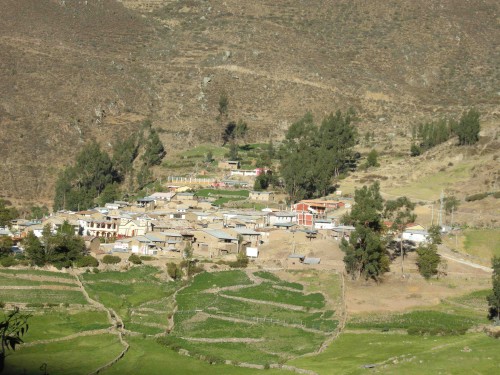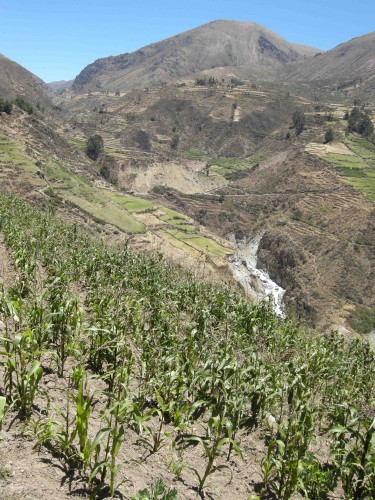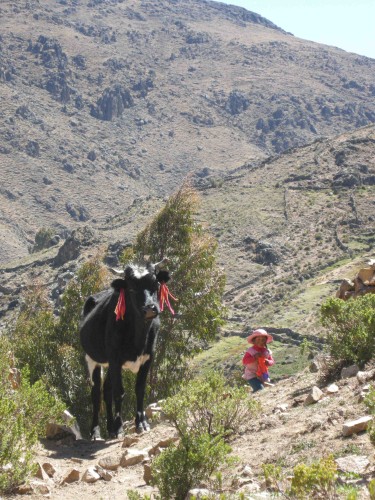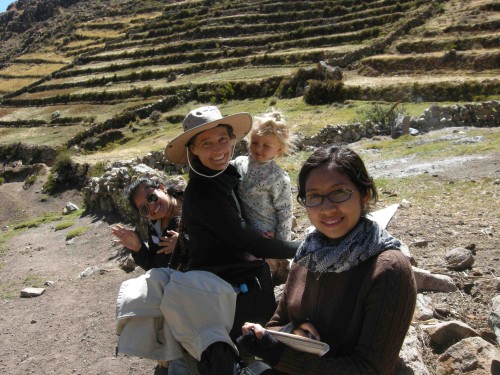Part Two: Santa Rosa de Tambo, 3,000 metres above sea level.

The Tambo River cuts sharply down the western flank of the Cordillera de los Andes, invisible on most maps, and difficult to access by any road. The name Tambo comes from Quechua tánpu, meaning army camp, storehouse or inn. As prehispanic waystations, the tambos were spread across the highroads of the Incan Peru. The town of Santa Rosa de Tambo lies settled into the northern slope of the canyon above the river. We heard that the town had lodging, as its name suggested, and that it perched on one of the two main tributaries of the Ica River. Our study of the energy-water-food security nexus took in the entire Ica Basin, from the coast to the highlands, and the two Peruvian departments the basin spanned. This town belonged to the department of Huancavelica, one of the more remote and poorer regions, with limited access to resources, and high indices of malnutrition.
Old buildings of stone and heavy adobe brick line the four sides of the small plaza, many with slanting roofs of weathered Spanish tile—tarnished black and most askew. Tin roofs of the newer buildings of the municipality glare in strong midday sun. The streets on the sides of the plaza are cement, but the rest of the roads through the village have packed white clay with loose stones. Tambo, at above three thousand meters of elevation is the highest ‘town’ of the Ica Basin. There are villages higher upstream, called annexes, the farthest just clusters of a few houses where extended families live together. Almost three hundred people live here, most of the year, and children come from many of the smaller villages to go to high school. The town has a resident doctor, a few different social workers, and small stores. We were told that the mayor only comes for the weekends.

Terraces step up above the town on the steep, grey mountainsides, and below all of the way down to the coursing white swath of river. This is the dry time of year before the rains come, and a grey, scraggly native vegetation giving texture to the slopes above the terraces, leaving only the steepest cliffs exposed. Acequias cut across at different levels, twelve in all, and irrigate level after level of fields. Stone walls form fences, lanes and large holding pens, and hold back the earth in the thousand terraces. Those just above and below the town glow deep green with alfalfa, and a few have been planted in favas and corn. Bare soil waits in those that will be planted with barley and wheat when the rains begin.
Over half of the terraces visible across the slopes, however, have been taken over with the African invasive grass called kikuyo (Pennisetum clandestinum). Though ironically a soil stabilizer, the deep-rooted alien species easily outcompetes native species where enough water is available, and takes over the annual crops of the slopes. The grass only “fills the stomachs” of the livestock, and does not offer enough nutrition to sustain them. The locals say it is the biggest threat to agriculture in the area. They fight it by hand and with chemical applications, but it is winning the battle, not only in Tambo, but in high mountain towns across Peru.
Most of the residents cultivate a few terraces, or lease theirs to be cultivated or grazed. Most own a pig, or a few lambs or goats, or cows that they milk to make cheese or yoghurt. Even villagers of the higher annexes live off the few soles earned from selling cheese. The cattle, to my surprise, were not hardy mountain cattle, but small, skinny Holsteins, perhaps over generations better adapted to the climate extremes. Many of the animals of all breeds wore brightly colored dangling cloth and wool strips as identifiers. In the driest times of year, those that can afford to buy feed sacks of ground corncobs and cottonseed meal from the valley. In the rainy seasons, many are turned loose onto the common grounds of the mountains.

In one of the higher annexes in the basin called Tinco, a cluster of three structures accessible only by walking hours along stony trails, I helped a woman to milk her cows. She hobbled the animal’s back legs together, and together, one on each side, we filled the stainless bucket with milk. I grew up milking cows by hand, but her firm grip yielded at least twice the volume of my own. She was a young woman, my own age perhaps, with a daughter a year older than mine. Our daughters watched from the stone wall at the edge. The woman filled a small cup of milk for her child. The rest of the several litres, she poured through a cloth into a large plastic bucket and stirred in a culture and rennet to set the curd. She would carry the cheese on her back down the trail to the nearest road, and it would eventually find its way to markets in Ica or Lima, both many, many hours distant.
Inside the simple kitchen, an old, blind man said that they used to walk the other way, upstream instead of downstream. The town of San Felipe, high on the altiplano, provided a few groceries, and farther, Ayacucho, the market for the cheese. It took three hours walking to reach the nearest road. Now, with the road up the valley, the entire commerce chain has switched direction. He said he does not make it into town, not even Tambo very often. His ancient wife served us bowls of soft noodles in thick broth. When I had asked if they eat cheese, milk, yoghurt, or any animal products, the younger woman had said no, that they try to sell everything. Instead, they live on cheaper, simple carbohydrates. After the rainy season, they would have potatoes, favas, and a few vegetables, but this time of year they did not have much to eat. The elderly man said he would really like to have a piece of squash, or a few carrots. And if we came back, would we bring him a radio?

Nacional de San Marcos.
The people in the village consisted of the elderly husband and wife, the young daughter-in-law that I helped with the cows, and another daughter-in-law who had just given birth to a child. She was not in bed, but out bringing in cows from the terraces, shy and bright faced. I wondered if she had any access to medical attention during the birth, or if pregnant women were afforded any of the livestock products to support their nutrition.
I had expected to find more diversity in food and agriculture in the higher, isolated villages of the basin. I had expected tradition to be intact, and diets to have a mix of wild foraged, cultivated crops, and animal products. To my surprise, food insecurity overtook water insecurity in the altitudes. Only a few people saved seed and still grew traditional grains. Most bought their potatoes, favas, wheat and barley from Ica or Ayacucho, and the variety of choices were limited. Rice, pasta, and newer potato varieties have largely replaced quinoa, favas, and the older varieties of nutrient-rich potatoes in the diet.
The road, perhaps three decades old has changed people’s access to markets and food. This mountain ‘tambo’ is a resting place for drivers instead of runners—though many people still easily walk several hours on steep trails among the annexes. Three to five cars a day make the trip from Santa Rosa de Tambo to Ica one way, a trip of more than five hours on the stony, narrow road, and they return or leave the following day. They take cheese products and people down, and return with supplies, and more people to the town. Many of the young men make their living driving, or working on state-funded road and canal projects instead of cultivating the terraces. Those left in the village are the elderly and the children. The money returned buys food, and now, electricity, cell phones, and the modern amenities, which have replaced traditional needs and exchange practices in the villages. Modernity has arrived to the Tambo, and with it, new challenges, new questions, and new dynamics in the security nexus.
More ‘Notes from an extreme gradient’:
